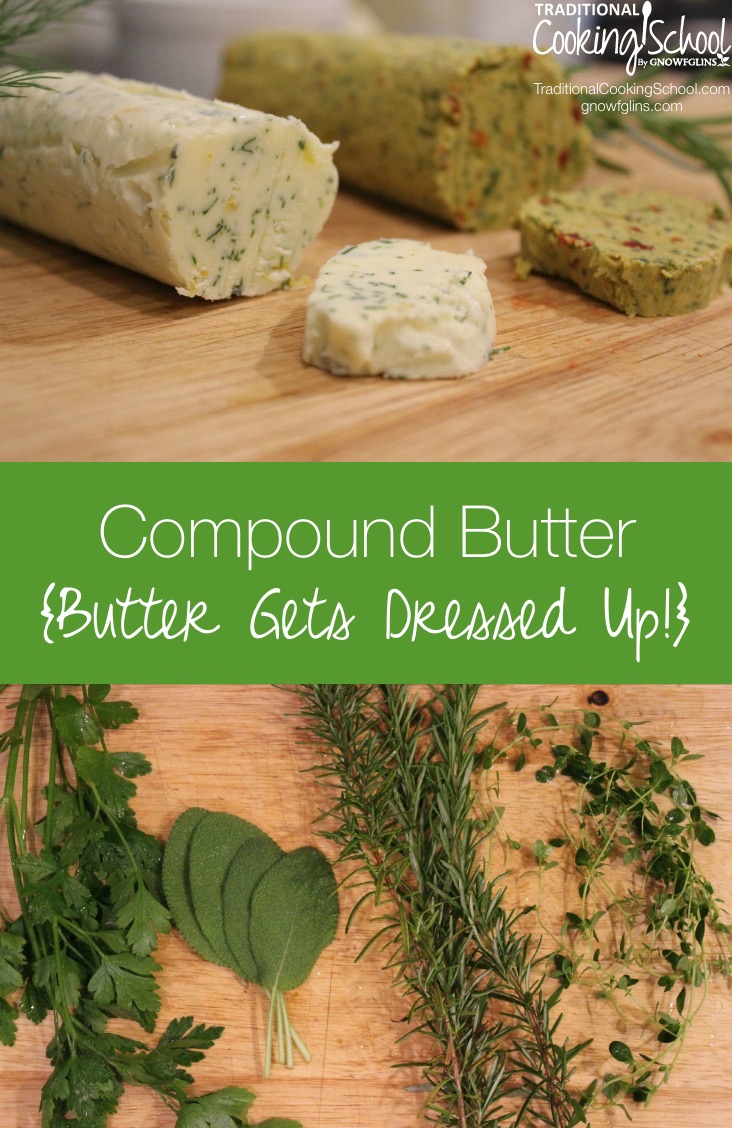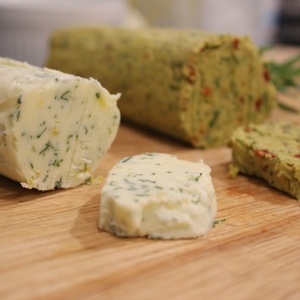
As a young married couple without kids, we moved to a new city eight hours from home. There, we met Mr. and Mrs. Samuels at church.
We loved getting invitations to eat dinner at their house. Sam, retired from the Navy, had filled their home with beautiful things from around the world. Helen was a pearls-go-with-everything, warm and friendly lady who knew how to make her guests feel welcome.
But what I remember most about the first evening we spent with them was the butter. I’d never tasted anything quite like it — real butter (at the time still quite a rarity for me) blended with fresh herbs from Sam’s garden and a little fresh garlic.
I couldn’t get enough. I spread it on everything from crackers, to bread, to potatoes, and anything else I could get away with.
The next week Helen brought me a tub of my own to take home and explained how it was made. “It’s compound butter,” she said. “You just mix up fresh herbs, whatever you want, into a pound of butter.”
Turns out this simple technique has been used for as long as there have been great cooks. If you’ve ever had honey butter, you’ve had compound butter. The legendary Escoffier himself used compound butters to add depth and flavor to all kinds of dishes.

The most widely used compound butter variation is called “Beurre Maitre d’Hotel” (the head waiter’s butter), and is used in high end restaurants around the world to accompany freshly baked bread, grilled steaks, or chops. It is fresh minced parsley, lemon juice, salt and pepper creamed into fresh unsalted butter that is rolled into a log and then chilled until the flavors mingle. Slices of the butter are placed atop hot sizzling steaks just before serving where they melt into the meat to make a simple yet delicious sauce.
Compound butters can be used in a myriad of ways. They are easy to make and they freeze well so they are handy whenever you need a quick flavor boost, an easy sauce, or a way to dress up simple food for company.
Here are just a few ways you can use compound butter:
- Top steaks, lamb chops, pork chops, fish
- Top steamed or roasted vegetables, or corn on the cob
- Melt over new potatoes or mix into mashed potatoes
- Spread on baguettes, muffins, toast, crepes
- Top pancakes, waffles, English muffins, biscuits, crackers
- Add an extra layer of flavor to sandwiches
- Swirl into soups
- Tuck underneath the skin of a chicken, duck, or turkey before roasting
- Melt into wine or balsamic vinegar reduction for a quick sauce
- Cook with scrambled eggs
- Toss with rice, quinoa, or pasta for a quick side dish
A food processor makes very quick work of it all, but it’s also simple to make by hand with just a wooden spoon and a bowl. You can use salted or unsalted butter, sweet or cultured — whatever pleases your taste buds. If you use unsalted butter, add a pinch or two of salt to your compound butter.
Let’s use the Beurre Maitre d’Hotel as a template for making basic compound butter.

Beurre Maitre d'Hotel
The most widely used compound butter variation is called “Beurre Maitre d’Hotel” (the head waiter’s butter), and is used in high end restaurants around the world to accompany freshly baked bread, grilled steaks, or chops.
Ingredients
- 2 sticks grass-fed butter at room temperature, (1/2 pound)
- 1/4 cup fresh parsley minced
- 1 tablespoon lemon juice freshly squeezed
- 1/2 teaspoon sea salt
- 1/4 teaspoon ground black pepper
Instructions
-
Use a food processor or a mixer with a whisk attachment to cream the butter.
-
Add the remaining ingredients and mix well. Place a large sheet of waxed paper or parchment paper on the counter and scoop the butter onto the paper.
-
Form the butter into a log shape about 4 inches tall. Roll the waxed paper around the butter so it's a tight log.
-
Fold or twist the ends and place in the refrigerator until firm.
-
To freeze place the wrapped log into a freezer-safe container or zip top bag.
Recipe Notes
- Compound butter lasts about 1 to 2 weeks in the refrigerator depending on what you used for the flavoring. Fresh herbs and juices don’t last as long while dried herbs and spices will last slightly longer. Freeze for longer storage (up to 6 months).
Flavor Combinations
Pretty much anything you think might taste good is fair game. Decide whether you want to use it with sweet or savory dishes, and think about what flavor combinations go well together. Draw inspiration from anything growing in your garden, or favorite cuisines (Italian, Mexican, or Thai, anyone?), or seasonal flavors (pumpkin pie spice or cranberry orange), or any of your favorite foods (olives, cheese, or mushrooms). Using the template above as a loose guide and substitute your own flavor combinations. For every two sticks (1/2 pound) of butter use 1/4 cup minced fresh seasonings OR 2 teaspoons dried. Use roughly 1 tablespoon of liquid ingredients. Keep in mind that if you use too much liquid you’ll end up with a tasty dip instead of a spread. Add sea salt if you are using unsalted butter. Here are some flavor ideas to get you started:
- Zest of 1 large organic orange, 1/4 cup sucanat or coconut sugar, 1 to 2 tablespoons fresh orange juice
- Parsley, sage, rosemary, and thyme (are you singing yet?)
- 1 tablespoon minced chipotle pepper, 1 tablespoon lime juice or zest, honey to taste
- Homemade pesto and lemon zest
- Parsley, dill, lemon pepper, and sea salt
- Cilantro, cumin, minced jalapeno, lime juice, and zest
- Oregano, rosemary, basil, parsley, and minced garlic (for an Italian combo)
- Tarragon, chives, Dijon mustard, and white wine
- Nasturtium flowers alone or with other herbs like chives
- Mint, oregano, lemon zest (for a Greek combo)
- Mint and harissa paste
- Sucanat and pumpkin pie spice
- Cilantro, garam masala or curry powder, and salt
- Sesame seeds, soy sauce, and fresh ginger
- Black mustard seed, minced jalapeno, fresh ginger, and turmeric
- Capers and white wine
- 3 to 4 slices cooked crumbled bacon, maple flavoring, maple syrup or honey
- Soy sauce, shallots, garlic, and hot chili pepper
- Kalamata olives, lemon zest, and fresh thyme
- Sundried tomatoes, garlic, and black pepper
- Finely chopped green onion, black pepper, and lemon zest
- Minced porcini, chanterelle mushrooms, garlic or shallots, and red wine
- Blue cheese or cheddar cheese and crumbled bacon
- Fresh blueberries or raspberries mashed, lemon zest, and coconut sugar
- Toasted finely chopped hazelnuts, cocoa powder, and coconut sugar
- Toasted finely chopped walnuts, shallots, garlic, sea salt, and pepper
Fresh butter and fresh herbs are both plentiful in the spring. So it’s a great time to try making your own compound butter!
Let us know what combination is your favorite!
We only recommend products and services we wholeheartedly endorse. This post may contain special links through which we earn a small commission if you make a purchase (though your price is the same).


I love the idea of using chipotle and tucking it under chicken skin!
I agree! I thought that was a GREAT idea!
Lovely post, Lee. Thanks!
I’m trying to figure out proportions. Can you help?
I was about to make several of these, the italian one in particular.
Have you made molasses butter? It’s delicious but again I’m stuck for proportions.
Here is the spot in the article where it mentions proportions: “For every two sticks (1/2 pound) of butter use 1/4 cup minced fresh seasonings OR 2 teaspoons dried. Use roughly 1 tablespoon of liquid ingredients.”